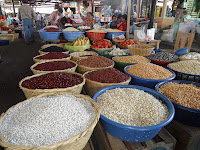 One thing I love about travelling in the Second World is the lack of the kind of spit and polish we in the West are so used to. There is no "one stop shop" like Woolies or Coles catering to your domestic needs in air conditioned comfort. Rather, here, the markets are the centre of daily life and one gets a feel for how people live, simply from wandering through the hustle and bustle, taking in the sights, sounds and smells.
One thing I love about travelling in the Second World is the lack of the kind of spit and polish we in the West are so used to. There is no "one stop shop" like Woolies or Coles catering to your domestic needs in air conditioned comfort. Rather, here, the markets are the centre of daily life and one gets a feel for how people live, simply from wandering through the hustle and bustle, taking in the sights, sounds and smells. Narrow alleyways and literal "holes in the wall" selling rows of chicken and fish; slabs of meat suspended on hooks, with the butcher carving off steaks as you watch. Rows of produce - limes, tomatoes, avocados and of course chillis - the shops repeated ad infinitum so that you wonder how the shoppers make their choice - is it price or quality? And live animals - ducks, turkeys and of course chickens - picked up from a basket, turned upside down, feet bound and unceremoniously pushed into a bag. As Hobbes would say, life for a chicken in Central America is nasty, brutish and short.
Narrow alleyways and literal "holes in the wall" selling rows of chicken and fish; slabs of meat suspended on hooks, with the butcher carving off steaks as you watch. Rows of produce - limes, tomatoes, avocados and of course chillis - the shops repeated ad infinitum so that you wonder how the shoppers make their choice - is it price or quality? And live animals - ducks, turkeys and of course chickens - picked up from a basket, turned upside down, feet bound and unceremoniously pushed into a bag. As Hobbes would say, life for a chicken in Central America is nasty, brutish and short. This lack of sophistication also has its humorous side. Murals, street-signs and other decoration lack the sort of finesse that we´re used to at home. It can lead to some strange sights. The picture on the right is called, Baby Jesus blesses the Mayans and your guacamole.

This one on the left I call, Hermann Cortez v Wonder Woman.
Lost in Translation
The Nuns were right - it does makes you shrivel up...

And in case, you're wondering whatever happened to Hermit and the Hermanns, here´s Hermann...
And the rest of the band...
Another odd thing about this part of the world are the clowns. I don´t think it would be going too far to say that the society is obsessed with them. They´re bloody everywhere. There's even one on late night TV - an old lecherous guy in greasepaint and wig, interviewing bikini models and local celebrities. Kinko eat your heart out! Here´s me with a much less creepy one, but again, this clown, walking the streets, with little explanation and barely a second glance. There´s a thesis in there somewhere...
 I´m currently in the city of Campeche, on the west (Atlantic) coast of Mexico. It's an UNESCO World Heritage listed city because of the fortress walls which encicle the town. These were built by the Spanish in the 17th Century, to ward off predominantly
I´m currently in the city of Campeche, on the west (Atlantic) coast of Mexico. It's an UNESCO World Heritage listed city because of the fortress walls which encicle the town. These were built by the Spanish in the 17th Century, to ward off predominantlyEnglish pirates like Sir Francis Drake. The skeleton pictures above are actually taken from the Pirate Museum, built into the city ramparts. As you can see, the exhibits were barely worth the 52 cent admission price!
























